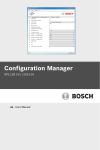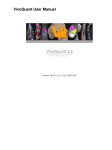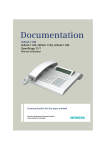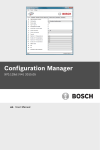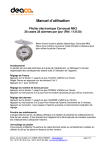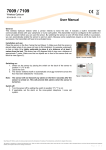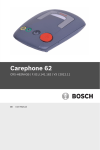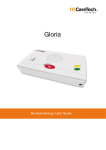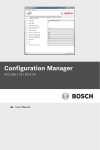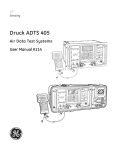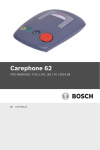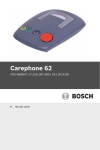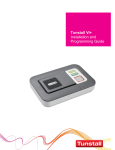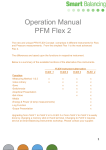Download Careline Anna / Careline GSM
Transcript
Careline Anna / Careline GSM Programming and installation manual Programming and installation manual Careline Anna / Careline GSM Doc. no. 32-022-03-01 EN v6 List of contents 1 Introduction ........................................................................................................................................................ 3 1.1 1.2 1.3 1.4 1.5 1.6 2 General description of Careline Anna/GSM ..................................................................................................................................... 3 General description of Tx4 alarm transmitter ................................................................................................................................. 4 New functions of Careline Anna/GSM ................................................................................................................................................. 4 Buttons, Careline Anna/GSM ...................................................................................................................................................................... 5 LEDs .............................................................................................................................................................................................................................. 6 Battery ......................................................................................................................................................................................................................... 6 Installation........................................................................................................................................................... 7 2.1 2.2 2.3 2.4 2.5 2.6 3 Programming......................................................................................................................................................................................................... 7 Connection to power supply ..................................................................................................................................................................... 7 Connection to the analogue telephone network ........................................................................................................................ 8 Connection to mobile network ................................................................................................................................................................ 8 Wall Mounting ...................................................................................................................................................................................................... 9 After Completed Installation ....................................................................................................................................................................... 9 Programming Structure ................................................................................................................................. 9 3.1 3.2 3.3 3.4 4 Table of Alarm Receiver Telephone Numbers ................................................................................................................................ 9 ...................................................................................................................................................10 Table for Alarm Types ....................................................................................................................................................................................10 Table for Sequences ........................................................................................................................................................................................11 Programming of the Hand Terminal ....................................................................................................... 11 4.1 4.2 5 Introduction to the Hand Terminal ......................................................................................................................................................11 Creating and Saving Programming in the Hand Terminal ..................................................................................................13 Programming of the carephone Careline Anna/GSM ...................................................................... 19 5.1 5.2 6 Programming of Careline Anna/GSM using the hand terminal ......................................................................................19 Programming via buttons on the top of the carephone ......................................................................................................21 Battery Replacement .................................................................................................................................... 23 6.1 6.2 7 Battery replacement for Careline Anna/GSM ................................................................................................................................23 Battery replacement for Tx4 ......................................................................................................................................................................24 Commands to the carephone ................................................................................................................... 25 7.1 8 Home phone ........................................................................................................................................................................................................25 Type of alarm................................................................................................................................................... 26 8.1 8.2 9 10 10.1 10.2 10.3 10.4 10.5 10.6 10.7 Overview .................................................................................................................................................................................................................26 Explanation............................................................................................................................................................................................................27 Description of menu selection in the hand terminal ........................................................................ 29 Appendix .......................................................................................................................................................... 38 Appendix A Appendix B Appendix C Appendix D Appendix F Appendix G Appendix H Specific information for your hand terminal .................................................................................................38 Factory default values for the reset hand terminal ..................................................................................40 Technical specifications for Careline Anna/GSM .......................................................................................44 Technical specifications Tx4 alarm transmitter ..........................................................................................45 Cable for input/output .................................................................................................................................................46 WEEE Directive ..................................................................................................................................................................47 Programming tree Careline Anna/GSM ..........................................................................................................48 Programming and installation manual Careline Anna / Careline GSM Doc. no. 32-022-03-01 EN v6 1 Introduction 1.1 General description of Careline Anna/GSM There are currently many types of telephony; therefore STT Condigi's new carephone comes in several models in order to allow you to communicate in different ways. You can make an analogue emergency call or via GSM, or calls can be sent as data traffic over IP or GPRS, this user manual describes the operation of the two analogue models: Careline Anna and Careline GSM. The manual for the most part covers both models, but the part that deals with GSM, of course, only applies to Careline GSM. When both models are referred to in the text it states, Careline Anna/GSM. Careline Anna and Careline GSM can transmit both speech and non-speech emergency alerts, to 10 different preprogrammed alarm recipients via the analogue telephone network and/or GSM network, and Careline GSM can also send alerts to 8 different alarm recipients via GPRS. The alarm recipients then forward the alarm to, for example, mobile phones, local wireless phones or an alarm centre, depending on the time and day. Dialling to the various alarm recipients is done in a predetermined sequence, and may differ depending on the type of alarm. The alarm activation is done by pressing the red button on the carephone or by pressing the red button on the portable alarm transmitter. If the transmitter is used the alarm signal is transmitted to the carephone using a radio signal. The carephone transmits the alarm to the pre-programmed alarm recipient. If it is a voice alarm, like the normal medical alarms, the emergency operator can hold a conversation with the person who activated the alarm. The carephone is equipped with both microphone and speaker and works as a speakerphone, which allows calls with no additional push of a button from the user's side. Conversation can be held in a normal sized apartment with good sound quality. The carephone Careline Anna/GSM is connected to the telephone network by a cable. If the carephone has GSM functionality it connects to the GSM network through a SIM card installed in the intended SIM card holder. For power supply the supplied AC/DC transformer is connected. In the event of a power failure the carephone is powered by the built-in accumulator (see section 1.6). In addition to the alarm transmitter, Tx4 can connect additional radio transmitted alarm accessories, such as door, IR or smoke alarms. Fixed-line alarms can be used through the STT Radiobox 869, T-box 869 or via the additional card in the carephone (note that it requires a specific model of Careline Anna which has an extra socket for this purpose.) In total, 16 radio-based devices can be connected at one time, including the Tx4, the portable alarm transmitter, which is supplied with the carephone. Grey Button Green Button Present Reset LED Status Red Button S Alarm t a t u s Microphone IR Receiver Speaker Image 1. Carephone Careline Anna/GSM Programming and installation manual Careline Anna / Careline GSM Doc. no. 32-022-03-01 EN v6 1.2 General description of Tx4 alarm transmitter Alarms can be activated with the alarm transmitter Tx4. When the red button is pressed a red LED lights up on the transmitter for a short period. When the alarm has been received by Careline Anna/GSM a signal is sent back to the alarm transmitter to confirm that the alarm has been activated, then a green LED lights up briefly. Tx4 uses dual frequency, which is a new feature that allows it to change frequency and transmit on another frequency if there is a disruption on the primary frequency. When an alarm is activated Tx4 first broadcasts on one frequency. If there is no response from the carephone the signal is repeated up to three times. After which, the Tx4 changes frequency and transmits on the second frequency, up to four times. This feature provides increased security and safety for the user. The radio frequencies used are the European-customised frequency for social alarms 869.2125 MHz and 868.3000 MHz. The Tx4 alarm transmitter can automatically send a link test to the carephone, which shows that the Tx4 is working properly and has contact with the carephone. If the link test does not reach the carephone it will send an alarm to a pre-programmed alarm recipient about the failure of the test alarm from the Tx. The function is activated in the carephone with the help of the handterminal. The alarm transmitter Tx4 is worn on a bracelet or necklace. The alarm transmitter is also waterproof (IP67) so that the alarm transmitter can be worn during a bath or shower. A new feature of the Tx4 is that change of battery is possible. See section 6.2. 1.3 New functions of Careline Anna/GSM Careline Anna/GSM has many new features and options. A selection of them is listed below. 1.3.1 Dual frequency Dual frequency allows Careline Anna/GSM to receive radio signals on two different frequencies 869.2125 MHz and 868.3000 MHz. Dual frequency provides extremely good security: if something were to disrupt the communication on one frequency, the alarm can reach the carephone on the second frequency. 1.3.2 Greater amount of telephone numbers and sequences In Careline Anna/GSM you can add 10 phone numbers and there are now 8 sequences. Each sequence can have 10 steps. Sequences can also be connected in series, so that when the carephone rings in accordance with one sequence, it can continue to call in a different sequence. This provides great opportunities for extensive and flexible programming. 1.3.3 GSM functionality With the Careline GSM you have the ability to activate an alarm over the mobile network, which provides good security if the analogue telephone network is down. For each telephone number you can choose if the communication is to be made via telephone lines or wirelessly via the mobile network. You can also send an alarm via GPRS. Therefore, you can also program internet addresses in the Careline GSM. You can set the APN you wish to connect to, and the PIN of the SIM card, if a PIN is to be used. 1.3.4 Illumination of the alarm button Something that has been requested is for the carephone's alarm button to be illuminated, so that it is easier to find in the dark. This feature is a part of Careline Anna/GSM. Illumination of the alarm button can be turned on or off, and you can also easily adjust the brightness to your liking. 1.3.5 Location code Careline Anna/GSM has a new feature which means that a location code can be entered for each alarm transmitter. Location codes are numbers that you can enter yourself for different places in the home, e.g., kitchen, bedroom, hall. In this way it is possible, for example, to know which door alarm has been activated, the one located at the main entrance or the patio door. Programming and installation manual Careline Anna / Careline GSM Doc. no. 32-022-03-01 EN v6 1.4 Buttons, Careline Anna/GSM Careline Anna/GSM has three buttons on the top, all designed to be easy to push on. The buttons are: Active Alarm (Red) Reset (Green) Present/Ready (Grey) When you press the alarm button (or alarm transmitter) the carephone normally waits for 10 seconds before the alarm is redirected. During this time, you hear an alarm signal and the alarm can be cancelled by pressing the green button. Some alarms ring silently, for example, technical alerts such as test alarms and the battery alarm. These cannot be cancelled with the green button. If you wish a Present/Finish function can be activated so that the grey button on the carephone can be used to register when staff are currently with the care recipient. (This is done via the hand terminal. The feature is found in the menu, "Plus Alarm.") When the staff arrives to the care recipient, they notify this by pressing the grey button on the carephone. When the button is pressed, the alarm signal and present indicator light up on top of the carephone. When the staff is ready to leave the care recipient, the grey button is pressed again and a received signal is heard. In this way, information on the length of stay can be collated in the system for each individual care recipient. 1.4.1 Table of the button features The table below describes the functions activated via buttons on the Careline Anna/GSM Control Press the red button in normal mode Press the red button when the phone is ringing ( 1) Press green button during the call ( 1) Press the grey button in normal mode (1) Hold the green button down, press the grey and red. Release on audio signal. Hold the green button down, press the grey and red. Release when the LEDs flash rapidly. Hold the green button down, 2 press the red button (1) Hold the green button and red button down for 3 s Press green button down during start-up Hold red button down during start-up (2) Press the grey button in the transmitter programming mode (2) Hold down the green button for three seconds (2) Function Alarm is activated The call is connected Dialling of the alarm is cancelled Present/Ready signal Programming Mode Restart Present/Ready Manual, test alarm Activate function test Programming mode of radio transmitters Deprogramming of radio transmitter Away mode is activated/deactivated 1) Requires that the feature is enabled in the carephone. 2) See instructions in section 5.2. For a description of the functions in the programming mode, see section 5.2 Programming and installation manual Careline Anna / Careline GSM Doc. no. 32-022-03-01 EN v6 1.5 LEDs On the top of the carephone there is a green light that indicates if the carephone has power, a yellow/orange light indicates the function present and a red light to indicate if something is wrong. The following table describes the LED signals and statuses. Signal Green fixed light Green flash (0. 5 s to / 4.5 s from) Green flash (0.5 s to / 0.5 s from) Green flash (1 s to / 1 s from) Green flash (2 s to / 2 s from) Green flash (70 ms to / 70 ms from) Yellow fixed light Yellow flash Green and yellow flash (2 yellow flashes per green flash) Green and yellow simultaneous flashing Status Normal operation Battery power Dialling Waiting to call again No more attempts Starting GSM module Staff present Carephone set in away mode Battery power and staff present Battery power and off mode enabled If the Warning System function is enabled, the LEDs provide additional information. The error that is indicated can be found by counting the number of times the green LED flashes while the red LED is lit. The green LED flashes are described in the table below. Number of Low Battery/ Mains No telephone flashes Charging failure connection 1 2 3 4 5 6 7 1.6 No No No Yes Yes Yes Yes No Yes Yes No No Yes Yes Yes No Yes No Yes No Yes Battery In order for the carephone to function even when there is a mains loss (power cut), there is a rechargeable NiMH battery in the carephone. The battery has a very long shelf life and the carephone sends a battery error when it needs replacing. Charging the battery starts automatically when voltage returns. Careline Anna and Careline GSM have different batteries. The standard battery in Careline Anna provides backup for about 100 hours. The rechargeable battery, which is standard in Careline GSM is more powerful and gives backup for up to 420 hours. Note! Only the battery supplied by STT Condigi may be used. Programming and installation manual Careline Anna / Careline GSM Doc. no. 32-022-03-01 EN v6 2 Installation Everything that is needed for the installation is: 1 Carephone 1 Telephone adaptor with cable 1 Mains adaptor On/Off (1/0) Telephone line in Telephone Mains adaptor Cable opening Battery SIM Card Image 2. Placement of connectors, battery and SIM card. 2.1 Programming The carephone must be programmed before it can be installed with the care recipient. To program the carephone, follow the instructions in section 5.1. 2.2 Connection to power supply The mains adapter is plugged into an ordinary electrical socket and to the socket on the back of the carephone marked 12V (see image 3 below). Then, turn on the switch (push button marked 0 / 1 to 1). Note! Careline Anna/GSM may only be used with the supplied mains adapter. Programming and installation manual Careline Anna / Careline GSM Doc. no. 32-022-03-01 EN v6 2.3 Connection to the analogue telephone network Connect the telephone cable into the supplied telephone adaptor and to the carephone in the socket closest to the on/off button (see Image 3 below). The regular telephone plug should be connected to the supplied telephone adaptor and then connected to the primary telephone socket at home. Note! It is important that the carephone is connected to the primary socket (the main socket) in the home in order to achieve complete security! If you do not do this, your carephone may not be able to call the alarm recipient, for example, if you have another phone in the home that is not on the receiver. To check which the primary socket is, lift all the handsets off the receivers in the home. The handset which still has a dial tone is the primary. If more than one handset has the dialling tone at the same time, the phone socket is not connected properly and must be adjusted by an authorised installer. Image 3. Here you can see in which jack the telephone cable (white) and mains adapter (black) are to be connected. 2.4 Connection to mobile network To insert a SIM card in Careline GSM: Loosen the screw to the battery cover and pull it out. Slide the SIM card into the holder as shown in image 4 below. Slide the battery cover back in place (hold the SIM card if it does not slide easily) and attach the cover with the screw. Image 4. Slide the SIM card into the SIM card holder. Programming and installation manual Careline Anna / Careline GSM Doc. no. 32-022-03-01 EN v6 2.5 Wall Mounting If the carephone is to be mounted on the wall, you can choose which way it should be mounted. Then press out the cover for the selected holes. The distance between holes is about 110 mm and 42 mm. It can be beneficial to use the back cover of the carephone as a template when you mark where to place the screws. Use screws with heads that fit the holes so that the carephone can easily be hung up and lifted off when necessary. 2.6 After Completed Installation After the basic programming, installation and programming of the alarm transmitter has been completed, carry out a function test. Carry out a range test (see instructions in Section 5.2.5) Try to send an alarm. If the alarm is to go via the analogue telephone line and via GSM - be sure to try both. Note! The back cover of the carephone should be on to ensure the best sound quality! 3 Programming Structure This section helps you to structure the values to be inserted into the hand terminal, which is then used to program the carephone. Read through it and then fill in the corresponding tables in Appendix A at the end of this manual. The completed tables facilitate the programming of the hand terminal. 3.1 Table of Alarm Receiver Telephone Numbers In order for Careline Anna/GSM to transfer an alarm to an alarm recipient via an analogue telephone line or GSM connection, it is necessary to program it with the following information: Phone number to the alarm receiver (or receivers if there are more than one) Protocol, i.e., which transfer method is to be used, such as STT, CPC, etc. Alarm code that tells the alarm receiver from which carephone the alarm has been sent Number of attempts the carephone shall make to the different alarm telephone numbers. If the communication is to go via analogue or via GSM. When the user programming has been completed, it may look like the table below. Fill in the values of your programming in the table in Appendix A. Number A B C D E F G H I J N (Nightmode) V (Forwarding) 1) 2) Telephone no. 0406252500 0406252500 0406252550 020223242 020223242 - Protocol STT STT STT STT STT - Alarm code ¹ 1234 1234 1234 111234 123456 - No of attempts 3 3 3 5 5 - Connection² Telephone line Wireless Telephone line Wireless Wireless - The alarm codes need only be entered if the alarm is to be sent with different alarm codes to the various alarm receivers. Only available if the carephone has GSM functionality. Note! Note that if you want to call the same number first over the telephone line and then wireless via GSM (or vice versa) you must enter this number twice (see code A and code B) and specify the different connection types. Programming and installation manual Careline Anna / Careline GSM Doc. no. 32-022-03-01 EN v6 3.2 Table of Alarm ddresses A major innovation in Careline GSM is the ability to communicate over GPRS. For the carephone to transfer an alarm to an alarm receiver via GPRS it is necessary to program it with the following information (this table is therefore only applicable if the carephone has GSM functionality). Internet address to an alarm receiver (or receivers if there are more than one) and port, separated by semicolons. Internet address can be entered both as text and as a numeric IP address. Protocol, i.e., which transfer method is to be used, STT IPACS is standard. Alarm code that tells the alarm recipient from which carephone the alarm has been sent Number of calls the carephone shall make to the different alarm telephone numbers. As Careline GSM does not have a fixed IP connection all communication to the IP addresses is wireless. When the user programming has been completed, it may look like the table below. Fill in the values of your programming in the table in Appendix A. No a b c d e f g h n (Nightmode) v (Forwarding) 3.3 Address 111.10.35.45:10000 222.20.35.45:10000 333.30.35.46:10000 444.40.38.48:10000 555.50.35.45:10000 - Protocol STT IPACS STT IPACS STT IPACS STT IPACS STT IPACS - Alarm code¹ 1234 1234 1234 111234 123456 - No of attempts 3 3 3 5 5 - Connection Wireless Wireless Wireless Wireless Wireless - Table for Alarm Types The types of alarms that are activated in the carephone, both the automatic and the manual, can be sent to different alarm receivers or be handled in a different manner depending on the type of alarm. For example, you can choose to deal differently with technical alarms than alarms activated by the care recipient, such as medical alarms. The table below shows a configuration example. Please note that Plus Alarm and Test Alarm can now be configured to run in different sequences and that the bedside alarm, carpet alarm and door alarm now have their own sequence, and are no longer sent in the same wayas a Passive Alarm. Fill in the values of your programming in the table in Appendix A. Type of alarm Medical alarm Passive Alarm Acc. /Mains Fire Person protect Extended Emerg./Remind. Assistance User defined Test Alarm Bed/Carpet/Door Sequence Sequence 1 Sequence 1 Sequence 2 Sequence 1 Sequence 3 Sequence 2 Sequence 1 Sequence 1 Sequence 1 Sequence 2 Sequence 1 Programming and installation manual Careline Anna / Careline GSM Doc. no. 32-022-03-01 EN v6 3.4 Table for Sequences When an alarm receiver does not respond to the call, the carephone can continue to call another alarm receiver. The table contains information about in which sequence the carephone shall contact the programmed phone numbers/addresses. This can vary between different alarm types (see Section 4.2.5). The Careline Anna/GSM has increased both the number of sequences and the number of steps in each sequence. Now you can enter as many as 8 sequences with 10 steps in each sequence. Cascading means that the carephone can continue to call with a different sequence if it does not get an answer on any of the attempts in the first sequence. When the programming has been completed, it may look like the table below. Note that the secondary number or address you choose to contact is not necessarily called by the carephone on the second attempt; it depends on how many calls have been entered for the respective number/address (see Section 4.2.2 and 4.2.3). The number listed in "Repeat sequence" is the number of times that the sequence is repeated, if the alarm does not get answered. If the value 1 is set, it means that the sequence is run once. If the value 2 is specified, it means that the sequence is run once and then repeated once. In the sequences the phone numbers are represented by upper-case letters and the addresses by lower-case. Fill in the values of your programming in the table in Appendix A. Sequence 1 Sequence 2 Sequence 3 Sequence 4 Sequence 5 Sequence 6 Sequence 7 Sequence 8 1st A a C D - 2nd B b C d - Repetition of Sequence 4 4.1 3rd A c C D - 4th B a C d - 5th b c e - 6th c c - 7th c - 8th c - 9th - 10th - Cascading Sequence 2 Sequence 4 - 2 Programming of the Hand Terminal Introduction to the Hand Terminal The carephone is programmed using a HT-III Hand terminal (see image 5), which connects to the back of the carephone using the supplied red wire. Connect carephone or press for offline The text in the display will be shown like this in the rest of the document. Image 5. Hand terminal HT-III with a 4-row display and buttons Programming and installation manual Careline Anna / Careline GSM Doc. no. 32-022-03-01 EN v6 The Hand terminal has a display on the top. The display shows the different lines of text that guide the user through programming. Below the display there are buttons for the digits 0-9 and letters A-Z as well as symbols such as Yes, No, , *, #, , T and OK. 4.1.1 Control Yes, OK No T General Functions of the Hand Terminal Function Accept the entered value or go forward in the menu Leave the current menu level, and ignore entered value Up in the menu Down in the menu Back one symbol Forward one symbol Enter 'wait for dial tone' in the phone number or activate the receiving of the radio code from the alarm transmitter Delete the symbol to the left of the cursor Careline Anna/GSM can be programmed to wait 500 ms before the phone is switched. Use -button when you enter the phone number to enter a W. The display of the hand terminal shows four rows such as: PHONE NUMBERS >Number A < Number B Number C There can be more rows in the menu that are not displayed. To switch between the different choices in the menu use and on the hand terminal. The current choice is marked with > and <. If, for example, you want to switch from A to C, press the button twice on the hand terminal. PHONE NUMBERS Number A Number B >Number C < 4.1.2 Memory in the Hand Terminal The Hand terminal has three different types of memory, where data is stored. The different memory functions are described here, and image 6 below shows how data is transferred between them. Work area Contains the values that you work with when using the hand terminal. You can obtain value from the carephone, or reset the area or any preset parts of the work area. The values that are applicable in the work area are the ones sent to the carephone. Note! If you make changes to the work area, but then quit the program without saving these values in the preset area, they will be gone the next time you connect the hand terminal. The area This area always has a basic setting which is standard for all the hand terminals and non-programmed carephones and as you can see in the image you can never change the data in the reset area. Preset area In the preset area you can find the data saved by yourself in the Hand terminal. When you start the Hand terminal the values are retrieved from the preset area 1. Each model of the carephone has seven own preset areas where you can save different settings. Programming and installation manual Careline Anna / Careline GSM Doc. no. 32-022-03-01 EN v6 Send changes Load std. values Reset Area Preset Area Upload on start up Working Arbetsarea Area Carephone Load from TT Save to preset menu selection Image 6. Data flow between the memory areas in the handterminal and the carephone. 4.2 Creating and Saving Programming in the Hand Terminal Follow these instructions step-by-step to program the default values that you want to program the carephone with, and save these in the preset area. All the values that are common for all carephones should be here. This saves you entering them each time you program a carephone, you can simply enter the values specific to this carephone (usually only the alarm code) and then transfer it with the default values you previously saved in the hand terminal to the carephone. Use the completed tables in appendix A to facilitate programming. Note! This section gives you a good basic programming, but the carephone offers many more possibilities than these! Please read section 8 in which almost all the features found in Careline Anna/GSM are described. 4.2.1 Connect the Hand Terminal Connect the mains adapter to the hand terminal's smallest outlet (see image 7 below) and to a standard electrical socket. Image 7. Connect the Hand terminal's smallest outlet, as per the image above. The display of the hand terminal shows the following: Connect to the carephone or press to stand alone Press on the hand terminal. The display will show: DEVICE TYPE >Careline GSM < Careline Anna Reflex Plus II Programming and installation manual Careline Anna / Careline GSM Doc. no. 32-022-03-01 EN v6 Choose the model you want to program by pressing and and then press Yes. Terminal VX.YSE connects Careline GSM MAIN MENU VX.YSE >Edit alarm code Speaker vol. Quit < Go to the next step: programming of the telephone number 4.2.2 Programming of the telephone number of the alarm receiver If an alarm is to ring via the analogue telephone network or via GSM, the telephone number must be entered. In that case, continue with the programming as follows: Edit alarm code Speaker vol. Quit >Programming < Enter password: - - - - < Choose Programming, press Yes PROGRAM >Phone numbers < Addresses Transmitters Enter code 1812 PHONE NUMBERS >Phoneno. A Phoneno. B Phoneno. C PROGRAMMING >Program < Load from phone Load std.values Choose Programming, and press Yes < Choose Phone numbers, press Yes. Choose Phoneno. A, press Yes Value in HT: <not programmed> New Value: XXX… Enter the phone number from the alarm number table in Appendix A. Write the numbers in sequence without a hyphen. To delete numbers if you accidentally press wrong, press. If you have to enter a 0 to access an outside line, enter 0 and then T before entering the usual number, for example, "0T040123456". T stands for Tone (Connection Tone). Finish by pressing Yes. Value in HT: <not programmed> New value: 0T040123456 Press for the next number and repeat the procedure above to add the telephone numbers B, C etc. Press No to exit the menu "Phone numbers". Programming and installation manual Careline Anna / Careline GSM Doc. no. 32-022-03-01 EN v6 4.2.3 Programming of the address of the alarm recipient If the carephone is the Careline GSM model, the alarm can be sent via GPRS. The Internet addresses of the alarm receivers shall be entered, according to the instructions below: PROGRAM Phone numbers >Addresses Transmitters < Choose Addresses, press Yes. ADDRESSES >Address a Address b Address c < Choose Address A, press Yes Value in HT: Enter the Internet address and port from the address table in Appendix A (may be in letters or numeric IP address). Any symbols you may need are on the buttons 1 and 0. To switch between upper-case and lower-case letters, press the *- button. Maximum 48 characters (16 in each row). To delete if you accidentally press wrong, press . Finish by pressing Yes. Value in HT: 111.10.35.45:100 00 Pressto the next address and repeat the procedure above to add the addresses B, C etc. Press No to exit the menu "Addresses". 4.2.4 Programming of protocol When sections 4.2.2 and/or 4.2.3 are finished, continue according to the below: Alarm types Location codes Alarm codes >Protocol < Choose Protocol, press Yes PROTOCOL >Protocol A Protocol B Protocol C < Choose Protocol A, press Yes Value in HT: <STT> New Value: <STT> Value STT has been acquired Press or until the protocol is shown in the "new value" field and press Yes to accept. Repeat the procedure for Protocol B, C etc. For each phone number entered in section 4.2.2, a protocol must be specified. The protocol for the addresses are below the protocols for telephone numbers, but there is the protocol STT IPACS default. Press No to exit the menu "Protocol". Programming and installation manual Careline Anna / Careline GSM Doc. no. 32-022-03-01 EN v6 4.2.5 Programming of Sequences The programming of sequences defines which alarm types shall call which alarm receiver and in what order. (See table in Appendix A.) Follow the instructions below Location code Alarm codes Protocol >Sequences < Choose Sequences, press Yes Value in HT: A B C D - - - - - New value: A B C D - - - - - - Preset value SEQUENCES >Def. sequence Def. alarmtypes Silent/Speech < DEF. SEQUENCE >Sequence 1 Sequence 2 Sequence 3 < Choose Def. sequence, press Yes Choose Sequence 1, press Yes Value in HT: A B C D - - - - - New value: A B C D - - - - - - Choose new value Use to switch between the eight values and positions and to change the value. The letters represent the listed phone numbers and addresses. If no telephone number is required for the current position, enter "-". When settings are entered, press Yes. Repeat this procedure for the other sequences that you need. Press No to return to the "Sequencing" menu. SEQUENCES Def. sequence >Alarm Types < Series connection Choose Alarm type, press Yes ALARM TYPES >Medical Alarm Passive Alarm Acc./Mains < Choose Medical alarm, press Yes Value in HT: <Sequence 1> New value: <Sequence 1> Choose Sequence 1, press Yes Choose which sequence shall be used for the different alarm types. For example, you can set it so that all care alarms ring as "Sequence 1 Press and until the right sequence is shown New value . Press Yes to accept. Repeat the procedure for all alarm types. Press No to exit the menu "Types of alarm". Alarm Types Cascading Silent/Speech >Repeat seq. < Choose Repeat seq., press Yes Value in HT: 1 New Value: 1 Value 1 has been preset Delete the existing value with and enter the desired number of sequence repetitions and press Yes. Press No once to leave the Sequences menu. Programming and installation manual Careline Anna / Careline GSM Doc. no. 32-022-03-01 EN v6 4.2.6 Programming of number of attempts If the carephone does not get through to transmit its alarm at the first attempt, it waits one minute and then attempts again. Here you can set the number of attempts to be made for each number/address before proceeding to the next step in the sequence. (See table in Appendix A.) Follow the instructions below. Alarm codes Protocol Sequences >Attempts < ATTEMPTS >Number A Number B Number C Choose Attempts, press Yes < Choose Number A, press Yes Value in HT: 5 New Value: 5 Value 5 is the default value Enter the desired number of attempts for the current number and press Yes. If you happen to mistype, press to delete. Repeat the procedure for Numbers B, C and address a, b, etc. For each phone number and address specified in Section 4.2.2 and 4.2.3 there should be a specified number of attempts. (5 is pre-programmed by default.) Press No to exit the menu Number of attempts . 4.2.7 Press No twice to leave the menu GSM functions .Programming of connection If you have a Careline GSM, you can for the phone number you provided choose how to be called, i.e., if it is done via the analogue line or via GSM. (See table in Appendix A.) Follow the instructions below to change. ¨ Protocol Sequences Attempts >Connect. type < Choose Connect. type, press Yes CONNECT. TYPE >Number A < Number B Number C Choose Number A, press Yes Value in HT: <Tele line> New Value: <Wireless> Value Tele line has been preset Choose the desired connection type by pressing and until the chosen connection type is shown under New value , and then press Yes.. Repeat the procedure for Number B, C etc. For each phone number entered in section 4.2.2, a connection type must be specified. (Tele line is pre-programmed by default.) Press No to exit the menu Connection . 4.2.8 GSM settings If the alarm is sent via GPRS, you have to change some settings for this connection. Plus Alarm In/Output Other >GSM functions< GSM FUNCTIONS >APN< Security Choose GSM functions., press Yes Choose APN, press Yes Enter the APN address. It can be numeric or with letters, and can contain max 48 characters. Press Yes. Programming and installation manual Careline Anna / Careline GSM Doc. no. 32-022-03-01 EN v6 Choose Security , press Yes. Choose SIM lock , press Yes. Choose if the SIM lock should be activated or not by using and . (The SIM lock means that you have a PIN code activated on your SIM card to increase security.) Press Yes to accept. If you want to activate the SIM lock, choose PIN code and press Yes. Enter the PIN code for the SIM card (note that the PIN must be have been set before, the carephone cannot do this) Press Yes to accept. Press No 4.2.9 Save in the preset area When all installations are complete they shall be saved in the hand terminal's preset area. PROGRAMMING >Program < Load from phone Load stdvalues Press No once Program Load from phone Load std.values >Save to preset. < Choose Save to preset, press Yes Enter password: - - - - Enter 1789 SAVE TO PRESET. State area: (1-7) 1 Choose preset area Press Yes if you want to save in area 1. Otherwise delete with and then write the number of the area you wish to save in and press Yes. Confirmation that the settings have been saved is displayed, press Yes. Press No once to return to the main menu. Edit alarm code Speaker Vol. >Quit < Programming Go to Finish, press Yes Send changes to phone? Press Yes / No Press No PROGRAMMING COMPLETED Disconnect the Hand terminal Disconnect the mains adaptor The programming is now complete and the hand terminal is ready to use! Remember to always test that everything works as you intended when you change any settings in the hand terminal. Program a carephone with these changes and test the alarm. Also check what happens if you do not respond to the alarm, i.e., that it goes to the secondary alarm receiver, etc. 4.2.10 Configure other settings to save in the hand terminal The above sections describe the step-by-step standard programming procedure in the hand terminal. It is also easy to make changes in other settings and save them. Use the menu map in Appendix H to find the specific function. Go in and change to the correct value and press Yes. Then follow the instructions in section 4.2.9 to save these settings. Programming and installation manual Careline Anna / Careline GSM Doc. no. 32-022-03-01 EN v6 5 Programming of the carephone Careline Anna/GSM Programming the carephone is easy to do with a pre-programmed hand terminal of the model HT-III (see section 4.2). Many of the more common programming services, such as programming of accessories and changing the speaker volume can also be done by using the buttons on top. Listed below are descriptions of the operation of the most common tasks. 5.1 5.1.1 Programming of Careline Anna/GSM using the hand terminal Connecting the hand terminal to the Careline Anna/GSM To connect the hand terminal to the Careline Anna/GSM, carry out the procedure below: Connect the hand terminal to the back of the carephone by disconnecting the mains adapter from the carephone and instead put the narrow end of the red cable into this socket (labelled 12V). The other end of the red cable should be connected to the hand terminal's middle socket. (See image 8 below.) Plug the mains adapter into the hand terminal's smallest socket. Turn on the carephone by setting the switch to 1. (If it was already turned on, restart it.) The hand terminal now connects automatically. Proceed with any further programming, as per with sections 5.1.2 and 5.1.3. Image 8. Connect the red cable to the carephone and HT-III, and connect the mains adaptor to HT-III. Programming and installation manual Careline Anna / Careline GSM Doc. no. 32-022-03-01 EN v6 5.1.2 Basic programming of Careline Anna/GSM Follow these instructions to provide the carephone with the obligatory information about the alarm code, telephone number, etc. Note! In order to carry out the basic programming it is necessary to have pre- programmed the hand terminal. Connect the hand terminal to the back of the carephone by disconnecting the mains adapter from the carephone and instead put the narrow end of the red cable into this socket. The other end of the red wire should be connected to the hand terminal's middle socket. Plug the mains adapter into the hand terminal's smallest socket. Turn on the carephone by setting the switch to 1. (If it was already turned on, restart it.) The hand terminal now connects automatically. Choose menu >Alarm codes< with the arrow keys on the hand terminal, press Yes Delete any old alarm code with the -button. Enter the new alarm code, press Yes Choose menu >Quit< with the arrow keys on the hand terminal, press Yes For the question of whether you want to transfer the changes to TT, press Yes. Wait until the transfer has finished. Disconnect the hand terminal and reconnect the mains adaptor to the carephone. Test that the alarm works by pressing the red button on the carephone. 5.1.3 Program an alarm transmitter with the hand terminal To program the alarm transmitter to the Careline Anna/GSM with the hand terminal, do the following (this is done to a carephone that is already pre-programmed with the standard settings): Connect the hand terminal to the back of the carephone by disconnecting the mains adapter from the carephone and instead put the narrow end of the red cable into this socket. The other end of the red cable should be connected to the hand terminal's middle socket. Plug the mains adapter into the hand terminal's smallest socket. Turn on the carephone by setting the switch to 1. (If it was already turned on, restart it.) The hand terminal now connects automatically. When the main menu appears, go to >Programming<, press Yes Enter code 1812 Choose menu >Program<, press Yes Choose menu >Transmitters<, press Yes Choose transmitter location (see table below), press Yes Press T (the carephone then beeps 4 times) and activate the accessory. 8 digits appear under New value . (It also states <OK> or<Low> which indicates whether the battery in the accessory is OK or if it needs changing.) Hold down the right arrow button until the display states <sending>. Wait until the text <sending> disappears, press Yes Press No three times. Choose >Quit<, press Yes Enter No to the question Send changes to phone? Press Yes/No . The accessory is now installed in the carephone. Disconnect the hand terminal and reconnect the mains adaptor to the carephone. Try to send an alarm from the programmed accessory. Programming and installation manual Careline Anna / Careline GSM Doc. no. 32-022-03-01 EN v6 Transmitter number Transmitter 1 Transmitter 2 Transmitter 3 Transmitter 4 Transmitter 5 * Transmitter 6 * Transmitter 7 * Transmitter 8 Transmitters 9 16 Name (default in hand terminal) Medical Medical Medical Fire Door alarm Bed alarm Carpet alarm Passive. (Remember to change the time if the alarm it to be sent immediately. This is done in the Hand terminal under >Time Alarm< and then >Passive Alarm<. Enter 0 and send the value by holding the right arrow button for a few seconds until <send value> is displayed.) Medical * Only works if your alarm receiver can handle these types of alarms. 5.2 Programming via buttons on the top of the carephone Many of the basic functions can be operated via buttons on the top of the carephone. In section 1.4 there is a list of these functions. 5.2.1 List of functions in programming mode Here is how to enter the programming mode and how to access the functions contained in the programming mode. To enter the programming mode: Hold the green button down, press the grey and red. Release on audio signal. Function Set the speaker volume Set LED brightness Activate range test Start teleprog. after 1 signal Program alarm transmitter Deprogram alarm transmitter Control Hold down grey, release after 1 beep. Then press grey to decrease, red to increase, green to save. There are 8 levels, 1-8 beeps. (See section 5.2.4.) Hold down grey, release after 2 beeps. Then press grey to decrease, red to increase and green to save. There are 10 levels, 1-10 beeps. Hold down the grey, release after 3 beeps. Hold down the grey, release after 7 beeps. Hold down the red, release after the number of beeps corresponding to the transmitter position you want to use. Activate the alarm transmitter to be programmed. (See section 5.2.2.) Hold down red, release after the number of beeps corresponding to the transmitting position you want to deprogram. Press the grey button. (See section 5.2.3.) To exit the programming mode Press the green button. The LED should be solid green when the carephone is in normal mode. Programming and installation manual Careline Anna / Careline GSM Doc. no. 32-022-03-01 EN v6 5.2.2 Programming the alarm transmitter via the buttons To program an alarm transmitter for Careline Anna/GSM without using the hand terminal, do as follows. Press the green button and hold. Also press the red and grey buttons and hold them down until an ascending beep is heard. You can then release all buttons. Now you are in the carephone programming mode, as indicated by the light switching between the LEDs. Hold down the red, and wait for the number of beeps that corresponds to the transmitter position you want to program. (See table in section 5.1.3.) When the correct number of beeps is heard, release the red button and activate the transmitter you want to program. A received signal is heard from Careline Anna/GSM when the radio code has been received. To program more transmitters, press the red button again and wait for the beep. Otherwise, press the green button to exit programming mode. Then try to send an alarm from the programmed accessory. Note! You can also program as per the previous carephones, by turning off the carephone and holding the red button when you restart it and then release the red button and activate the transmitter in line with the correct number of beeps. 5.2.3 Deprogramming the alarm transmitter via the buttons Press the green button and hold. Also press the red and grey buttons and hold them down until an ascending beep is heard. You can then release all buttons. Now you are in the carephone programming mode, as indicated by the light switching between the LEDs. Hold down the red, and wait for the number of beeps that corresponds to the transmitter position you want to program. (See table in section 5.1.3.) When the correct number of beeps is heard, release the red button and briefly press the grey button. A received signal is heard and the alarm transmitter is then deprogrammed. To deprogram more transmitters, press the red button again and wait for the beep. Otherwise, press the green button to exit programming mode. Note! You can also deprogram as per the previous carephones, by turning off the carephone and holding the red button when you restart it and then release the red button and press the grey button in line with the correct number of beeps. 5.2.4 Change the speaker volume You can easily change the speaker volume, even if you do not have a hand terminal available. Press the green button and hold. Also press the red and grey buttons and hold them down until an ascending beep is heard. You can then release all buttons. Now you are in the carephone programming mode, as indicated by the light switching between the LEDs. Press the grey button down until you hear a beep. Then release the button. The carephone now gives off a number of beeps corresponding to the speaker volume that is currently selected. The volume is adjustable between 1 and 8 beeps. o To increase the volume: press the red button o To decrease the volume: press the grey button Every time you press the grey or red button, the carephone speaker volume is indicated by both the number of beeps and the adjusted volume level. When you are satisfied with the level, press the green button to save the settings. Then press the green button again to exit the programming mode. Programming and installation manual Careline Anna / Careline GSM Doc. no. 32-022-03-01 EN v6 5.2.5 Range test The range test is designed to be able to test the range of the alarm transmitter to ensure that it has range over the area you have in mind, such as the entire area of the care recipient's apartment. The range test also provides information as to the battery level of the alarm transmitter. Press the green button and hold. Also press the red and grey buttons and hold them down until an ascending beep is heard. Then release all buttons. Now you are inside the programming mode, as indicated by the light switching between the LEDs. Press the grey button down until you hear three consecutive beeps. Release the button and the carephone then replies with four beeps. With maximum 1 minute intervals, the alarm transmitter can now be tested. o One short beep means that the accessory is programmed and the battery is OK. o One long beep means that the accessory is programmed, but the battery level in the accessory is low and needs replacing. o Two short beeps means that the accessory being used has not been programmed for the current carephone but the alarm gets through and the battery is OK. o Two long beeps means that the accessory being used has not been programmed for the current carephone, and the battery level in the accessory is low and needs replacing. Remember to test the range everywhere in the apartment as there may be materials in walls, etc. that obstruct the radio signal from the alarm transmitter. When one minute has passed without a test, the range test is automatically terminated. To end the range test manually, just press the green button. Then press the green button again to exit the programming mode. Note! You can conduct the range test as per the previous carephones, by turning off the carephone and holding the green button when you restart the carephone. 6 6.1 Battery Replacement Battery replacement for Careline Anna/GSM When the battery needs replacing (i.e., when the carephone sends accumulator alarms) do the following: Remove the back cover of the carephone. Switch off the appliance using the power switch and unplug all connectors from the carephone. Remove the screw from the battery holder (see image 9) with a T8 torx screwdriver. Pull out the battery holder (see image 10). Disconnect the cable on the spent battery and connect a new battery (see image 11). Slide the battery holder in place (press the SIM card if the battery holder does not slide easily) and attach it with the screw Replace all cables and the cover. Image 9. Unscrew the battery holder. Image 10. Pull out the battery holder. Image 11. Loosen the cable and connect the new battery. Programming and installation manual Careline Anna / Careline GSM Doc. no. 32-022-03-01 EN v6 6.2 Battery replacement for Tx4 The battery can be replaced in the Tx4 alarm transmitter. Order a battery replacement kit from STT Condigi. It contains a new battery, a new silicon cover and a new plastic bottom part. NB! Only batteries supplied by STT Condigi may be used. When the alarm transmitter is worn, it should always have a mounted ring (for bracelet or necklace). The ring is extra protection against water ingress. Replace the battery according to the following instruction: Image 12. Pull the ring upwards and remove it. Image 14. Pull the silicon cover out and upwards to remove it. Image 16. Slide the new battery in. The plus side should be upwards. Image 13. Grab the silicon cover. Image 15. Turn the transmitter upside down to get the circuit board out. Press the battery out sideways. If you need to use a tool, be careful not to scratch the circuit board. Image 17. Place the circuit board in the new plastic bottom part. Make sure the hole at the edge of the circuit board is placed over the elevation at the edge of the plastic bottom part. Image 19. Attach the ring by pressing it on from the back of the transmitter until a click sound is heard. Make sure the elevation on the inside of the ring fits to the notch of the plastic bottom part of the transmitter. Image 18. Turn the new silicon cover inside out and place it against the circuit board before you turn it back. Programming and installation manual Careline Anna / Careline GSM Doc. no. 32-022-03-01 EN v6 25 7 Commands to the carephone The person answering the alarm can by pressing buttons on the phone give commands to the carephone and set it in different modes. These commands differ between different protocols and alarm receivers. Below the commands of the home phone protocol are listed. For other protocols, see the specification of the protocol and talk to the current alarm central on what commands to use. 7.1 Command 1,3 2 5 6 7 8 9 Home phone Action Switch to simplex mode, change speech direction Switch to duplex mode Increase microphone and speaker Disconnect the call Switch to simplex mode, connect microphone Switch to simplex mode, connect speaker Relay action Programming and installation manual Careline Anna / Careline GSM Doc. no. 32-022-03-01 EN v6 26 8 Type of alarm 8.1 Overview Depending on what caused the alarm, different types of alarms are sent to the alarm receiver. The table below lists all alarm types, whether it is possible to cancel the alarm with the reset button and whether voice communication with the care recipient is possible. Type of alarm Cancel Speech Medical alarm Medical alarm with low battery Automatic battery alarm Passive Alarm Fire alarm Accumulator alarm Broken accumulator Mains failure Mains return Assault alarm Assault alarm with low battery Test Alarm Emergency Alarm Reminder alarm Assistance Alarm Present Ready Action Door alarm Bed alarm Carpet alarm Fall alarm Medicine alarm Gas Water CO Lost test alarm Tx1 Lost test alarm Tx2 Lost test alarm Tx3 Lost test alarm Tx4 Lost test alarm Tx5 Lost test alarm Tx6 Lost test alarm Tx7 Lost test alarm Tx8 Link return Tx1 Link return Tx2 Link return Tx3 Link return Tx4 Link return Tx5 Link return Tx6 Link return Tx7 Link return Tx8 Yes Yes No No Yes No No No No No No No No No Yes No No No No No No No No No No No No No No No No No No No No No No No No No No No Yes Yes No No Yes No No No No Yes ( 1) Yes ( 1) No No No Yes No No No No No No No No No No No No No No No No No No No No No No No No No No No 1) Only listening, the carephone speaker is not connected Programming and installation manual Careline Anna / Careline GSM Doc. no. 32-022-03-01 EN v6 27 8.2 Explanation The following is a description of the different alarm types. Medical alarm What is known as an active alarm. The alarm is activated by the portable alarm transmitter/carephone. Medical alarm with low battery Same as above, but also indicates that the alarm transmitter's battery is faulty. Automatic battery alarm A device that sends an alarm to the carephone using radio communication (eg. Tx4 alarm transmitter, STT Radiobox 869 or STT Smoke Detector 869) has a battery which is running low. Passive Alarm A radio transmitter (e.g., a IR detector), set to be activated at regular intervals, which is not activated within the given timeframe sends a Passive Alarm. Fire alarm Alarm from a smoke detector with radio transmitter. Accumulator alarm The alarm is sent in the event of a power cut when the battery is about is running low. If it happens during mains operation, it is time to replace the battery in the carephone. Broken accumulator Indicates that the rechargeable battery is faulty and should be changed. Mains failure Indicates that the carephone is now powered by the battery, due to mains failure. Mains return Indicates that the carephone has returned from battery to mains operation. Note! This function must be activated in the Carephone. Test Alarm The carephone sends an alarm, once every 24 hours; to the alarm receiver to verify that the connection works. The period between the test alarms can be programmed with the hand terminal. Assault alarm The carephone can, via the hand terminal, be programmed so that instead of the normal medical alarm, an assault alarm is sent. Assault alarm with low battery As above, but also indicates that the alarm transmitter's battery is faulty. Emergency Alarm There is a special staff alarm transmitter that generates an emergency alarm. Reminder alarm If no member of staff assists the care recipient or if they forget to mark the present status a reminder alarm is generated. This function can be programmed. Assistance Alarm If a member of staff has marked the present status with the care recipient, an assistance alarm is activated when the alarm transmitter or alarm button of the care recipient is pressed. Note! This function must be switched on in the carephone. Programming and installation manual Careline Anna / Careline GSM Doc. no. 32-022-03-01 EN v6 28 Present Indicates that the staff came to the care recipient and pushed the present button. Ready Indicates that the staff who was in attendance, intends to leave the care recipient. Action Through the hand device, Report, the staff can enter which work has been done with the care recipient. The action alarm sends this information to the alarm receiver. Door alarm Special type of alarm for the connected door alarms. Bed alarm Special type of alarm for the connected bed alarm. Carpet alarm Special type of alarm for the connected carpet alarm. Fall alarm Special type of alarm for the connected fall detector. Medicine Special type of alarm for the connected medical dosage device, Careousel 869. Gas Special type of alarm for the connected gas detector. Water Special type of alarm for the connected flood detector. CO Special type of alarm for the connected CO detector. Lost test alarm If the alarm transmitter has not sent its test alarm as per the test alarm routine, the carephone sends a link test alarm to the alarm receiver. Since more than one alarm transmitter can be programmed to the carephone, the failed test alarms have been numbered. Note! This function must be activated in the carephone. Link return Indicates that the carephone regained contact with the alarm transmitter. Programming and installation manual Careline Anna / Careline GSM Doc. no. 32-022-03-01 EN v6 29 9 Description of menu selection in the hand terminal Main menu Edit alarm code Means that the carephone sends the same alarm code to all programmed alarm receiver. To send different alarm codes to different alarm receivers, go instead to the menu >Alarm codes<. The alarm code can contain a maximum of 16 digits. Speaker volume Controls the volume of the speaker in steps from 0 to 7, where 0 is the lowest value and 7 is highest. Here you can control the call volume and the volume of the audio signals of the carephone, for example, before an alarm call. Quit At quit, the user is asked do you want to send changes to the carephone. Answer Yes, and all the programmed values are transferred from the hand terminal to the carephone. Answer No, and the programming is terminated without transferring any values. Note that values not saved in the preset area are lost if you choose to quit. Load from preset Means you can download the preset values, which is then saved in the memory area. Every time HT is started, the preset values from area 1 are downloaded automatically. Programming Specify the code 1812 to go to the next step in the menu. Programming Load from Phone All values stored in the carephone are read. The reading takes a few seconds. Load standard values Erases the memory in the hand terminal and loads the factory preset values. There is then no information relating to phone numbers, alarm codes and alarm transmitters. Save to preset This means that programming changes that have been executed are stored in the hand terminal memory. You are requested to enter a code, which is 1789. All program changes which are not specific for an individual carephone should be stored with this command. There are seven memory areas for each carephone model. The values stored in area 1 appear every time you connect the carephone. Load from preset Means you can download the preset values saved in any of the memory areas. Every time HT is started it automatically downloads the preset values from area 1. (The same menu choice is in the main menu.) Program Means that you enter the menu where all the parameters you want to program or change are representated. >Phone numbers< >Addresses< >Transmitters< >Alarm types< >Location codes< >Alarm codes< >Protocol< >Sequences< >Attempts< >Connection type< >Outgoing call< >Incoming call< >Timers< >Extended<>I/O< >Options< >GSM functions< >Advanced< >Phone version< >Menu version< Programming and installation manual Careline Anna / Careline GSM Doc. no. 32-022-03-01 EN v6 30 Program Telephone number Here you can program the telephone numbers to the alarm receivers when the alarm is called via an analogue telephone line or via GSM. This is done under the numbers A to J, the nightmode and redirected. >Number A< to >Number J< >Nightmode N< >Temp redir. V< The telephone numbers, in addition to digits, can contain W and T. W means that the carephone shall wait 500ms before the number is dialled. T stands for wait for the dialling tone, which is used, for example, when connected to a PBX where you have to dial 0 or 00 to get a dialling tone in order to make external calls. If the number you are calling is 123456 and you need to dial 0 first, it is written 0T123456. The maximum number of digits in the telephone number is 16. Addresses Here you can program the Internet addresses of the alarm receivers when the alarm is sent via GPRS. This is done under the addresses a to h, the night mode and redirected. >Address a< to >Address h< >Nightmode n< >Temp redir. v< The addresses are entered either as letters or as numerical IP addresses and may contain no more than 48 characters. Note that the port must also be stated. Transmitters Here you can program the portable alarm transmitters or other transmitter's radio codes. >Transmitter 1< to >Transmitter 16< The care recipient's alarm transmitter is often programmed as >Transmitter 1<. It is possible to program an additional 15 radio based transmitters for the care recipients at the >Transmitter 2<, >Transmitter 3< etc. Different types of transmitters can be programmed, such as door alarm, bed alarm and fire alarm. Alarm types Here you can program the types of alarm which shall be sent to the care receiver when the respective transmitter is activated. >Transmitter 1< to >Transmitter 16< >External 1< >External 2< >Extra Button< >User defined< These submenus are multiple-choice, i.e., you cannot enter your own value, but must choose with the buttons and from a list. Under >Transmitter 1< to >Transmitter 16< you can see the alarm types for the radio based alarm transmitters and under >External 1< and >External 2< for any wire connected accessories. In the same way, under >Extra button< you can specify the type of alarm to be sent when you press the grey button on the Careline Anna/GSM. The default settings do not have this key enabled. Under >User defined< you can create your own type of alarm. You state which identification code is to be sent in the protocol used. Location codes A location code can be added for all radio transmitters and for the carephone. >Transmitter 1< to >Transmitter 16<> Carephone< The location code indicates where the carephone or alarm transmitters are located. It is stated as a numerical value, which you yourself can define such as kitchen, bedroom or living room. The values can be between 0 and 255. Note! This feature only works in certain protocols, such as STT, STT IPACS and BS 8521. Programming and installation manual Careline Anna / Careline GSM Doc. no. 32-022-03-01 EN v6 31 Alarm codes In this menu you can define individual alarm codes for all the different alarm numbers and addresses. This is used if you want alarms to use different alarm codes depending on the alarm receiver. (If the alarms are to have the same alarm code, irrespective of the alarm receiver, the alarm code is entered in >Edit alarm code<in the main menu.) The alarm codes may not contain more than 16 digits. The menu selection is: >Alarm code A< to >Alarm code J< >Nightmode N< >Temp redir. V< >Alarm code a< to > Alarm code h< >Nightmode n< >Temp redir. v< The function >Replace digit< is used to change one or two digits at the end of an alarm code for a digit that corresponds to the alarm transmitter's sequence number. This function can be used when several alarm transmitters have been connected to a care telephone, and you want to know which of them was activated by the alarm. In the selection >Change digit< there is a submenu. >Function< >No. of digits< Function Here you can enter whether the function shall be enabled and if so which alarm type shall be applicable. The alternatives are <Not enabled>, <Medical>, <Protection > and <Medical/Protection>. No. of digits Here you can specify whether one or two digits at the end of the alarm code must be replaced. The alternatives are <Repl. 1 digit> and <Repl. 2 digits>. Protocol Specifies which communication protocols are to be used for the communication. What protocols you can choose between is defined by the software variant. The last menu choice, BS8521 PIN, is only used when the protocol BS8521 is used. Then a code is registered which gives the alarm central the access to change parameters in the carephone by entering this code. >Protocol A< to >Protocol J< >Nightmode N< >Temp redir. V< >Protocol a< to > Protocol h< >Nightmoden< >Temp redir. v< >BS8521 PIN< Sequences This menu has sub-menus, which mainly manage the order in which telephone numbers and addresses shall be called / contacted and for which alarm types. >Def. sequence< >Def. alarm type< >Cascading< >Repeat seq.< >Demand disconnection< Def. sequence Has a submenu where you can define the sequences, that is, in which order the alarm numbers and Internet addresses of alarm receivers should be contacted if no one responds to the alarm. See Section 3.4 for more detailed description. >Sequence 1< to >Sequence 16< Note that upper-case letters stand for numbers and lower case letters for addresses! Def. alarm type Has a submenu where you select the alarm types to call as per the sequence. See Section 3.3 for more detailed description. >Medical Alarm< Passive Alarm< >Acc../Mains< >Fire< >Person protect< >Plus< >Emerg./Remind.< >Assistance < >User defined< >Test Alarm< >Bed/Carp./ Door< >Silent/Speech< Silent/Speech In a submenu you can for user-defined alarm types and for door, carpet and bed alarms indicate if the alarm should be with speech, i.e., that speech contact is connected with the person who receives the alarm, or of it should be a silent alarm, that is, no talk contact is connected. >User defined< >Bed/Carp./Door< Programming and installation manual Careline Anna / Careline GSM Doc. no. 32-022-03-01 EN v6 32 Cascading Here you can choose the order of the sequences. If, for example, under >Sequence 1< you choose <Sequence 3>, then an alarm that is set to call according to sequence 1 shall continue to call as sequence 3 when all attempts to sequence 1 is completed. You cannot create a loop by referring sequence 1 to sequence 2 and sequence 2 to sequence 1. However, if you chose to repeat sequences, they will run several times. Maximum of 40 attempts can be made in total (100 attempts for the alarm type Plus Alarm). >Sequence 1< to >Sequence 8< Repeat. sequence In this menu, specify how many times the sequences shall run. The value can be set between 1 and 9, the factory default is 1. Note that the value applies to all four sequences. Max 40 attempts in total is possible. Demand disconnection In this menu choose what Careline Anna/GSM should do if the call does not disconnect properly, but speech communication has been established. Choose <Yes> Careline Anna/GSM will call again. Choose <No> Careline Anna/GSM will not call again. The default value is <No>. Note! If you receive alerts in STT Mobile alarm, the above set-up requiring disconnection will not be valid. There the alarm is disconnected even if speech communication has been disconnected as a member of staff has opted to take it, and therefore has the responsibility for this alarm. Attempts Has a submenu where you can specify how many attempts Careline Anna/GSM shall make to contact the alarm receiver on the respective phone number/address. >Number A< to >Number J< >Nightmode N< >Temp redir. V< >Address a< to > Address h< >Nightmode n< >Temp redir. v< You can enter values between 1 and 9. If you enter values greater than 9, Careline Anna/GSM will still not make more than 9 attempts. The default value is 5. Remember that an attempt may take from several minutes (depending on whether the carephone reaches the alarm receiver or not) so there should not be too many attempts on the primary number. Connection type This menu is only available in Careline GSM and has a submenu where for each phone number and address you can specify the type of connection used. >Number A< to >Number J< >Nightmode N< >Temp redir. V< >Address a< to > Address h< >Nightmode n< >Temp redir. v< On the phone numbers you can specify whether the alarm is to call via the <Tele line> or <Wireless>. For the addresses, you can in the Careline GSM only enter <Wireless>, as this communication goes over GPRS. Outgoing call Has a submenu, which controls functions that are used when the carephone is dialling. >Precall signal< >Dial tone detection< >Mute dialling< Polarity change< Precall signal Determines what type of signal is heard in the loudspeaker on the Careline Anna/GSM when a medical alarm is activated. The menu is multiple-choice <Type 1> <Type 2> <Type 3> <Type 4> and <Not activated>. The factory default is <Type 1>. Programming and installation manual Careline Anna / Careline GSM Doc. no. 32-022-03-01 EN v6 33 Dial tone detection Specifies whether the Careline Anna/GSM shall detect the dial tone or not, before a telephone number is dialled. If you specify <Activated> the carephone waits until it hears a dialling tone before the number is rolled. If you specify <Not activated> the Careline Anna/GSM waits a couple of seconds before the number is rolled. The factory default is <Activated>. This setting only applies to the analogue alarm calls. Mute dialling Specify if you want to hear the numbers being dialled and the carephone's communication with the alarm receiver in the loudspeaker on the carephone or not. The factory default is <Not activated>. Polarity change Specify if the carephone shall detect alternation on the telephone line. Factory default is <Activated>. Incoming call Control of the features used when someone calls to the carephone. >Transmitter Answer< >Ringing signal< >Tele prog signal< Transmitter Answer If the transmitter answer is activated, the care recipient can answer an incoming call by pressing the alarm transmitter. The carephone then acts as a standard speakerphone. By repressing the alarm transmitter the telephone call is terminated. In Careline GSM you can choose to activate transmitter answer for the telephone line, the GSM connection or both. Ringing signal If the incoming call ringing signal is activated, the carephone also rings when someone calls to a care recipient. Tele programming signal Specifies after how many ringing signals Careline Anna/GSM shall respond in the remote programming mode when dialling to the care recipient. The number of signals should normally be 0, which means that the carephone never answers the call. Possible values are 0 to 255. Factory default is 0. Timers Has a submenu, where you can check all alarms that are controlled by a timer. >Test Alarm< >Link Test< >Away function< >Mains failure< >Mains return < >Passive Alarm< Test Alarm Has a submenu consisting of: >Interval< >First Alarm< >Next Alarm< >Interval< is a menu choice where you specify how many hours between test alarms. If you want the carephone to sound the test alarm once a day, then enter the value 24. If 0 is entered the test alarm function is deactivated. The factory default is 24. >First Alarm< determines how many hours before the first test alarm is sent. The value can be between 0 and 240, but in practice between 0 and 24. The factory default is 24. >Next Alarm< is a menu choice where you can read the value in hours until the next test alarm. The value cannot be changed in this menu, only read. Programming and installation manual Careline Anna / Careline GSM Doc. no. 32-022-03-01 EN v6 34 Link Test Has an additional submenu consisting of: >Activation< >Interval< >Linktest 9-16< Under >Activation< you can choose between five alternatives. <Activated> which means that the test alarm shall be activated from the alarm transmitter. <Recurrent> which means that if Careline Anna/GSM has registered a link test failure, Careline Anna/GSM will send an alert every time interval expires until it receives a new test alarm from the alarm transmitter or that a new alarm transmitter is programmed in the same position. <Return alarm> which means the same as the Activated alternative but, you will also get an alarm when the transmitter is in contact with the carephone again. <Recur+return> which means the same as the Recurrent alternative but, you will also get an alarm when the transmitter is in contact with the carephone again. <Not activated> means that this function is not used. The factory default is <Activated>. >Interval< defines how many hours before Careline Anna/GSM sends Lost test alarm Tx . The value can be between 28-255 hours (factory default is 52). The alarm transmitter sends a test alarm every 23rd hour. Under >Linktest 9-16< the link test function can be activated for transmitter positions 9-16. Link test is only activated on position 1-8 in the default settings. Away function Can be set as <Activated> or <Not activated>. The away function can be used if the care recipient, for example, shall be away from home. If the function is activated, you can then hold down the green button for 3 seconds to set the carephone in the away mode. When this done, a message is sent to the alarm receiver stating that the carephone is in away mode. Where the care recipient returns, they can once again hold the green button for 3 seconds to disable the away mode. While the carephone is in away mode, no passive alarm or link test alarm is sent. A yellow LED flashes to mark the away mode. Mains failure Determines the delay in hours before Careline Anna/GSM sends a loss of power alarm after a power failure. Possible values are 0 -255 hours. The value 0 means that no loss of power alarm is sent. A value of 1 means that a loss of power alarm is sent within one hour. Practical values are between 1 and 7 hours. Factory default is 1 hour. Mains return Determines if Careline Anna/GSM will send a return of power, when power is restored. If this feature is enabled, notice of return of power is sent from Careline Anna/GSM from 5 to 35 minutes after the power returns. The factory default is <Not activated>. Passive Alarm Determines the time in hours before the passive alarm is sent. Possible values are 2 -254 hours. In practice, this means that if the value is set to 24, the first alarm is sent after about 24 hours. The time can also be set to 0 which means that the alarm is triggered directly for, e.g., door alarms. Factory default is 24 hours. Extended Has a submenu, which controls the status of all functions in the carephone. >Presence< >Ready< >Action< >How to send< >Emergency< >Assistance< >Reminder Time<>No. of reminders< >Prefix D< >Prefix N, V< Presence, Ready and Action These are used to send information to the alarm receiver that the staff have arrived at the care recipient, has carried out an action and is ready for departure from the care recipient. These functions can be activated or deactivated by selecting <Activated> or <Not activated> in the list that appears. A finish signal is triggered automatically, a certain number of hours after a presence indicator, if it has not previously been registered manually (the number of hours is programmable, the default is 8 hours). Programming and installation manual Careline Anna / Careline GSM Doc. no. 32-022-03-01 EN v6 35 How to send Time Indicates whether>Presence<, >Action<and>Ready<should be sent individually, together or together with the test alarm. Emergency (Staff Alarm) Provides opportunity for staff to sound the alarm if they feel threatened. They then use a special alarm transmitter (personal transmitter with radio code 22222222) recognised by all Careline Anna/GSM apparatus in the area which have the function activated, thus triggering the alarm. The appliances that have triggered the alarm, indicate where the alarm has come from and the necessary assistance can be routed to the right location. Assistance If this function is activated the assistance alarm can be sent. This occurs if the personnel are marked as present on the carephone and someone presses the usual alarm transmitter or the red button on the carephone. An emergency assistance can then go out to other staff. This function is used when the staff are on the premises of the care recipient and need extra help. Reminder time Allows automated calling to the alarm receiver unless the staff have come to the care recipient, and have marked their presence within a certain time. During this time, Careline Anna/GSM is blocked for further medical alarms, medical alarms with low battery, emergency alarms, door alarms, bed alarms, carpet alarms and user defined alarms. Careline Anna/GSM can be programmed to send a reminder alarm, 4 to 254 minutes after the medical alarm. Value 0 means that the function is deactivated. Number of reminders Determines the number of reminder alarms (between 1 and 20, factory default is 10). The time until the next reminder alarm is halved for each new alarm down to where the alarm is sounded every four minutes. >Prefix D< and >Prefix N, V< Allows you to add numbers before the alarm code for dialling number D, nightmode or temp. redirected. At a central alarm centre you can see from which location the alarm has been activated. Max 4 digits can be entered. Value <Not programmed> indicates that the function is not used. I/O Door opener >Activation< >Interval< Under >Activation< you decide to which transmitter position the door opener is to be added. The door opener will be added as a standard Tx alarm transmitter. <Not activated> indicates that the door opener function is off. >Interval< indicates how long the door shall be open. 1-25 sec can be stated. Multi-input There are three Multi-input positions. Multi-function input means that if you connect a transmitter with multiple inputs on one of the transmitter positions, you activate the various inputs of different transmitter positions. If you program a transmitter at position 3, the input 1 on the transmitter will activate the position 3, input 2 activate position 4, and so on. Choose <Sender 1-16> or <Not activated>. Programming and installation manual Careline Anna / Careline GSM Doc. no. 32-022-03-01 EN v6 36 External out >Function< Here you can determine what happens when you activate the relay. <Phone activate> used if you want to activate the relay via an alarm centre by pressing '9 'on a mobile phone. < Alarm relay> In this mode , the relay will be activated whenever an active alarm is detected and the Careline Anna/GSM call the alarm central. So the relay will be triggered whenever a medical alarm, fire alarm, bed alarm, etc is generated. Technical alarms will not trigger the relay. The relay is activated the green button. <Ring Indicated> used if you want to activate the relay when someone is calling. <TX remote 1> used to activate the relay by pressing twice on the Tx button. To manually deactivate the relay press 3 times on the Tx button if the relay has been activated. <TX remote 2> used to toggle the relay by pressing twice on the Tx button. To manually deactivate the relay press 3 times on the Tx button if the relay has been activated. <Presence> used to activate the relay when marking presence. When marking ready the external exit relay will be deactivated. <Alarm Receipt> used to activate the relay when an alarm has been sent to an alarm receiver and has been received by the alarm receiver. <System Warning> used to activate the relay when the function System Warning indicates that something is wrong. For more information about the System Warning , see below. >Activation time< Determines how long the exit shall be activated. External input >External 1< and >External 2< <Normal open> The external input is activated once closed. <Normal closed> The external input is activated once opened. <Presence> The external input is activated when there is a connection and sends a presence indication to the alarm receiver. <Ready> The external input is activated when there is a connection and sends a ready indication to the alarm receiver. <Presence/Ready> When closed a presence indication is sent. When the next closed is indicated a ready indication is sent. <Red button> In this mode the external input has the same function as the red top button. <Green button> In this mode the external input has the same function as the green top button. <Grey button> In this mode the external input has the same function as the grey top button. Other > System Warning< >Activation< >Warn. sources< Once system warning is activated, the LEDs flash and/or a sound emanates from the speaker. Choose <Visual> <Acoustic> <Both> or <Not activated>. The system warning indicates low battery, mains failure or that the line has disappeared. By pressing the green reset button the audible warning is stopped. The acoustic/visual warning can be programmed individually directly or independently via the hand terminal. These signals only appear when Careline Anna/GSM is in normal mode. See light signal table in Section 1.5. Under >Warn. sources< you can define which of the following warnings the system warning should indicate: >Line failure<, >Mains failure<, >Acc failure< and >GSM failure<. (The last-mentioned is only available in Careline GSM.) For example should the line failure warning be deactivated when you send all the alarms via GSM and no phone line is connected. Programming and installation manual Careline Anna / Careline GSM Doc. no. 32-022-03-01 EN v6 37 >LED indicators< In this menu you can set the >Level< of the LEDs on the top of the carephone. This applies to both the LEDS in the red alarm button and the LEDs that signal the status on the carephone. Here under >Alarm button light< you can also set the alarm button LEDs to be activated or not. GSM functions Has a submenu for the SIM card settings. >Activation< >Power save< >APN< and >Security< Under >Activation< you can choose to deactivate the internal GSM module in the carephone. No calls can then be called or received via GSM. As default, the function is activated. When >Power save< is activated, the GSM module is turned off during mains failure, and is only activated during alarms. If the power save mode is activated, it is therefore not possible to use the transmitter answer function on calls via GSM during mains failure. NB! If the power save mode is activated and the transmitter answer function is activated for the GSM connection, the battery backup time during mains failure will decrease significantly. Under >APN< you can state the network you want to use for the internet. For >Security< there is a submenu that controls the security of the SIM Card. By using a SIM card with PIN code, you minimise the risk that someone else can use your SIM card in their mobile telephone. >SIM Lock< controls if you use a SIM card with PIN in Careline GSM. Can be set as <Activated> or <Not activated>. Under <PIN code> you can enter the PIN code for the SIM card. Advanced Has a submenu for the advanced settings. This menu is blocked with a code. TT version When you connect the hand terminal to the carephone, you can read to see the software version of Careline Anna/GSM. Menu version You can read the version of the menus in the hand terminal. Programming and installation manual Careline Anna / Careline GSM Doc. no. 32-022-03-01 EN v6 38 10 Appendix 10.1 Appendix A Specific information for your hand terminal Fill in all the information below, it facilitates matters for you to know how the carephone is programmed. (For example, see Section 3.1 and 3.2.) Table for telephone numbers for communication via the analogue telephone network or GSM Phone number Protocol Alarm code Attempts Connection type A . . . . B . . . . C . . . . D . . . . E . . . . F . . . . G . . . . H . . . . I . . . . J . . . . N (nightmode) . . . . V (Redirected) . . . . Table for addresses to the alarm receivers, for GPRS communication IP address / port Protocol Alarm code Attempts a . . . . b . . . . c . . . . d . . . . e . . . . f . . . . g . . . . h . . . . n (night mode) . . . . v (redirected) . . . Programming and installation manual Careline Anna / Careline GSM Doc. no. 32-022-03-01 EN v6 39 Table for sequences for the respective alarm types Fill in the table below with information regarding in which sequence the respective alarm types shall be sent. (For example, see Section 3.3.) Alarmtype Sequence Medical Alarm . Passive Alarm . Acc./Mains alarm . Fire . Assault Alarm . Extended . Emergency Alarm . Assistance Alarm . User defined . Test Alarm . Bed/Carpet/Door . Table for sequences Table for sequences table contains information about the sequence the alarm receivers are to be called, and possibly also the sequence the carephone shall continue if it did not get through as per first sequence. (For example, see Section 3.4.) Note in the specification of numbers/addresses that upper-case letters stand for numbers and lower-case letters stand for Internet addresses. 1st 2nd 3rd 4th 5th 6th 7th 8:e 9:e 10:e Cascading Sequence 1 .......... .......... .......... .......... .......... .......... .......... .......... .......... .......... .............................. Sequence 2 .......... .......... .......... .......... .......... .......... .......... .......... .......... .......... .............................. Sequence 3 .......... .......... .......... .......... .......... .......... .......... .......... .......... .......... .............................. Sequence 4 .......... .......... .......... .......... .......... .......... .......... .......... .......... .......... .............................. Sequence 5 .......... .......... .......... .......... .......... .......... .......... .......... .......... .......... .............................. Sequence 6 .......... .......... .......... .......... .......... .......... .......... .......... .......... .......... .............................. Sequence 7 .......... .......... .......... .......... .......... .......... .......... .......... .......... .......... .............................. Sequence 8 .......... .......... .......... .......... .......... .......... .......... .......... .......... .......... .............................. Rep. of sequence ...................... Programming and installation manual Careline Anna / Careline GSM Doc. no. 32-022-03-01 EN v6 40 10.2 Appendix B Factory default values for the reset hand terminal Path Factory default Own value Speaker volume Program/ Phonenumbers / Number A Program/ Phonenumbers / Number B Program/ Phonenumbers / Number C Program/ Phonenumbers / Number D Program/ Phonenumbers / Number E Program/ Phonenumbers / Number F Program/ Phonenumbers / Number G Program/ Phonenumbers / Number H Program/ Phonenumbers / Number I Program/ Phonenumbers / Number J Program/ Phonenumbers / Nightmode N Program/ Phonenumbers / Temp redir. V 7 Not programmed Not programmed Not programmed Not programmed Not programmed Not programmed Not programmed Not programmed Not programmed Not programmed Not programmed Not programmed Read only Program/ Addresses / Address a Program/ Addresses / Address b Program/ Addresses / Address c Program/ Addresses / Address d Program/ Addresses / Address e Program/ Addresses / Address f Program/ Addresses / Address g Program/ Addresses / Address h Program/ Addresses / Nightmode n Program/ Addresses / Temp redir. v Not programmed Not programmed Not programmed Not programmed Not programmed Not programmed Not programmed Not programmed Not programmed Not programmed Read only Program/ Transmitters / Transmitter 1 Program/ Transmitters / Transmitter 2 Program/ Transmitters / Transmitter 3 Program/ Transmitters / Transmitter 4 Program/ Transmitters / Transmitter 5 Program/ Transmitters / Transmitter 6 Program/ Transmitters / Transmitter 7 Program/ Transmitters / Transmitter 8 Program/ Transmitters / Transmitter 9 Program/ Transmitters / Transmitter 10 Program/ Transmitters / Transmitter 11 Program/ Transmitters / Transmitter 12 Program/ Transmitters / Transmitter 13 Program/ Transmitters / Transmitter 14 Program/ Transmitters / Transmitter 15 Program/ Transmitters / Transmitter 16 Not programmed Not programmed Not programmed Not programmed Not programmed Not programmed Not programmed Not programmed Not programmed Not programmed Not programmed Not programmed Not programmed Not programmed Not programmed Not programmed Program/ Alarm Types / Transmitter 1 Program/ Alarm Types / Transmitter 2 Program/ Alarm Types / Transmitter 3 Program/ Alarm Types / Transmitter 4 Program/ Alarm Types / Transmitter 5 Program/ Alarm Types / Transmitter 6 Program/ Alarm Types / Transmitter 7 Program/ Alarm Types / Transmitter 8 Program/ Alarm Types / Transmitter 9 Program/ Alarm Types / Transmitter 10 Program/ Alarm Types / Transmitter 11 Program/ Alarm Types / Transmitter 12 Program/ Alarm Types / Transmitter 13 Program/ Alarm Types / Transmitter 14 Program/ Alarm Types / Transmitter 15 Program/ Alarm Types / Transmitter 16 Program/ Alarm Types / External 1 Program/ Alarm Types / External 2 Program/ Alarm Types / Extra button Program/ Alarm Types / User ID Medical Medical Medical Fire Door Bed Carpet Passive. Medical Medical Medical Medical Medical Medical Medical Medical Not activated Not activated Not programmed Not programmed Programming and installation manual Careline Anna / Careline GSM Doc. no. 32-022-03-01 EN v6 41 Program/ Location code/ Transmitter 1 Program/ Location code/ Transmitter 2 Program/ Location code/ Transmitter 3 Program/ Location code/ Transmitter 4 Program/ Location code/ Transmitter 5 Program/ Location code/ Transmitter 6 Program/ Location code/ Transmitter 7 Program/ Location code/ Transmitter 8 Program/ Location code/ Transmitter 9 Program/ Location code/ Transmitter 10 Program/ Location code/ Transmitter 11 Program/ Location code/ Transmitter 12 Program/ Location code/ Transmitter 13 Program/ Location code/ Transmitter 14 Program/ Location code/ Transmitter 15 Program/ Location code/ Transmitter 16 Program/ Location code / Carephone Not programmed Not programmed Not programmed Not programmed Not programmed Not programmed Not programmed Not programmed Not programmed Not programmed Not programmed Not programmed Not programmed Not programmed Not programmed Not programmed Not programmed Program/ Alarmcodes / Alarmcode A Program/ Alarmcodes / Alarmcode B Program/ Alarmcodes / Alarmcode C Program/ Alarmcodes / Alarmcode D Program/ Alarmcodes / Alarmcode E Program/ Alarmcodes / Alarmcode F Program/ Alarmcodes / Alarmcode G Program/ Alarmcodes / Alarmcode H Program/ Alarmcodes / Alarmcode I Program/ Alarmcodes / Alarmcode J Program/ Alarmcodes / Nightmode N Program/ Alarmcodes / Temp redir. V Program/ Alarmcodes / Alarmcode a Program/ Alarmcodes / Alarmcode b Program/ Alarmcodes / Alarmcode c Program/ Alarmcodes / Alarmcode d Program/ Alarmcodes / Alarmcode e Program/ Alarmcodes / Alarmcode f Program/ Alarmcodes / Alarmcode g Program/ Alarmcodes / Alarmcode h Program/ Alarmcodes / Nightmode N Program/ Alarmcodes / Temp redir. v Program/ Alarmcodes / Replace digit / Function Program/ Alarmcodes / Replace digit / Number of digits Not programmed Not programmed Not programmed Not programmed Not programmed Not programmed Not programmed Not programmed Not programmed Not programmed Not programmed Not programmed Not programmed Not programmed Not programmed Not programmed Not programmed Not programmed Not programmed Not programmed Not programmed Not programmed Not activated Change 1 digit Program/ Protocol/ Protocol A Program/ Protocol/ Protocol B Program/ Protocol/ Protocol C Program/ Protocol/ Protocol D Program/ Protocol/ Protocol E Program/ Protocol/ Protocol F Program/ Protocol/ Protocol G Program/ Protocol/ Protocol H Program/ Protocol/ Protocol I Program/ Protocol/ Protocol J Program/ Protocol/ Nightmode N Program/ Protocol/ Temp redir. V Program/ Protocol/ Protocol a Program/ Protocol/ Protocol b Program/ Protocol/ Protocol c Program/ Protocol/ Protocol d Program/ Protocol/ Protocol e Program/ Protocol/ Protocol f Program/ Protocol/ Protocol g Program/ Protocol/ Protocol h Program/ Protocol/ Nightmode n Program/ Protocol/ Temp redir. v Program/ Protocol/ BS8521 PIN STT STT STT STT STT STT STT STT STT STT STT Not programmed STT IPACS STT IPACS STT IPACS STT IPACS STT IPACS STT IPACS STT IPACS STT IPACS STT IPACS Not programmed Not programmed Programming and installation manual Careline Anna / Careline GSM Doc. no. 32-022-03-01 EN v6 42 Program/ Sequence/ Def. sequence / Sequence 1 Program/ Sequence/ Def. sequence / Sequence 2 Program/ Sequence/ Def. sequence / Sequence 3 Program/ Sequence/ Def. sequence / Sequence 4 Program/ Sequence/ Def. sequence / Sequence 5 Program/ Sequence/ Def. sequence / Sequence 6 Program/ Sequence/ Def. sequence / Sequence 7 Program/ Sequence/ Def. sequence / Sequence 8 Program/ Sequence/ Def. alarmtype / Medical Program/ Sequence/ Def. alarmtype / Passive Program/ Sequence/ Def. alarmtype / Acc./Mains Program/ Sequence/ Def. alarmtype / Fire Program/ Sequence/ Def. alarmtype / Person protect. Program/ Sequence/ Def. alarmtype / Plus Program/ Sequence/ Def. alarmtype / Emerg./Remind Program/ Sequence/ Def. alarmtype / Assistance Program/ Sequence/ Def. alarmtype / User defined Program/ Sequence/ Def. alarmtype / Test alarm Program/ Sequence/ Def. alarmtype / Bed/Carp./Door Program/ Sequence/ Def. alarmtype / Silent/Speech / User defined Program/ Sequence/ Def. alarmtype / Silent/Speech / Bed/Carp./Door Program/ Sequence/ Cascading / Sequence 1 Program/ Sequence/ Cascading / Sequence 2 Program/ Sequence/ Cascading / Sequence 3 Program/ Sequence/ Cascading / Sequence 4 Program/ Sequence/ Cascading / Sequence 5 Program/ Sequence/ Cascading / Sequence 6 Program/ Sequence/ Cascading / Sequence 7 Program/ Sequence/ Cascading / Sequence 8 Program/ Sequence/ Rep. of seq. Program/ Sequence/ Demand disconn. ABCD -----ABCD -----ABCD -----ABCD -----ABCD -----ABCD -----ABCD -----ABCD -----Sequence 1 Sequence 1 Sequence 1 Sequence 1 Sequence 1 Sequence 1 Sequence 1 Sequence 1 Sequence 1 Sequence 1 Sequence 1 Silent Silent Not activated Not activated Not activated Not activated Not activated Not activated Not activated Not activated 1 No Program/ Attempts / Number A Program/ Attempts / Number B Program/ Attempts / Number C Program/ Attempts / Number D Program/ Attempts / Number E Program/ Attempts / Number F Program/ Attempts / Number G Program/ Attempts / Number H Program/ Attempts / Number I Program/ Attempts / Number J Program/ Attempts / Nightmode N Program/ Attempts / Temp redir. V Program/ Attempts / Address a Program/ Attempts / Address b Program/ Attempts / Address c Program/ Attempts / Address d Program/ Attempts / Address e Program/ Attempts / Address f Program/ Attempts / Address g Program/ Attempts / Address h Program/ Attempts / Nightmode n Program/ Attempts / Temp redir. v 5 5 5 5 5 5 5 5 5 5 5 5 5 5 5 5 5 5 5 5 5 5 Program/ Connection type/ Number A Program/ Connection type/ Number B Program/ Connection type/ Number C Program/ Connection type/ Number D Program/ Connection type/ Number E Program/ Connection type/ Number F Program/ Connection type/ Number G Program/ Connection type/ Number H Program/ Connection type/ Number I Program/ Connection type/ Number J Program/ Connection type/ Nightmode N Tele line Tele line Tele line Tele line Tele line Tele line Tele line Tele line Tele line Tele line Tele line Programming and installation manual Careline Anna / Careline GSM Doc. no. 32-022-03-01 EN v6 43 Program/ Connection type/ Temp redir. V Program/ Connection type/ Address a Program/ Connection type/ Address b Program/ Connection type/ Address c Program/ Connection type/ Address d Program/ Connection type/ Address e Program/ Connection type/ Address f Program/ Connection type/ Address g Program/ Connection type/ Address h Program/ Connection type/ Nightmode n Program/ Connection type/ Temp redir.. v Tele line Wireless Wireless Wireless Wireless Wireless Wireless Wireless Wireless Wireless Wireless Program/ Outgoing call / Precall signal Program/ Outgoing call / Dialtone detec. Program/ Outgoing call / Mute dialling Program/ Outgoing call / Polaritychange Type 1 Activated Not activated Activated Program/ Incoming call / Transm. answ. Program/ Incoming call / Ringing signal Program/ Incoming call / Teleprogsign. Not activated Not activated 0 Program/ Timers / Test Alarm/ Interval Program/ Timers / Test Alarm/ First Alarm Program/ Timers / Test Alarm/ Next Alarm Program/ Timers / Link Test/ Activation Program/ Timers / Link Test/ Interval Program/ Timers / Link Test/ Linktest 9-16 Program/ Timers / Away function Program/ Timers / Mains failure Program/ Timers / Mains return Program/ Timers / Passive Alarm 24 24 Activated 52 Not activated Not activated 1 Not activated 24 Program/ Plus Alarm/ Presence Program/ Plus Alarm/ Ready Program/ Plus Alarm/ Action Program/ Plus Alarm/ How to send Program/ Plus Alarm/ Emergency Program/ Plus Alarm/ Assistance Program/ Plus Alarm/ Reminder Time Program/ Plus Alarm/ No. of reminder Program/ Plus Alarm/ Prefix D Program/ Plus Alarm/ Prefix N,V Activated Activated Activated Together Not activated Not activated 0 10 Not programmed Not programmed Program/ I/O /Exit/ Door Opener/Activation Program/ I/O /Door Opener/Opening Time Program/ I/O /Multi input1 Program/ I/O /Multi input2 Program/ I/O /Multi input3 Program/ I/O /External out /Function Program/ I/O /External out /Activation Time Program/ I/O /External input /External 1 Program/ I/O /External input /External 2 Not activated 0 Not activated Not activated Not activated Not activated 8 Not activated Not activated Program/Other/ SystemWarning/Activation Program/Other/ SystemWarning/Warn.sources/Line failure Program/Other/ SystemWarning/Warn.sources/Mains failure Program/Other/ SystemWarning/Warn.sources/Acc. failure Program/Other/ SystemWarning/Warn.sources/GSM failure Program/Other/LED indicators/Level Program/Other/LED indicators/Alarm btn LED Not activated Activated Activated Activated Activated 9 Activated Program/ GSM functions/Activation Program/ GSM functions/Power save Program/ GSM functions/APN Program/ GSM functions/Security/SIM lock Program/ GSM functions/Security/PIN code Activated Activated Not programmed Not activated Not programmed Programming and installation manual Careline Anna / Careline GSM Doc. no. 32-022-03-01 EN v6 Read only 44 10.3 Appendix C Technical specifications for Careline Anna/GSM Weight: (excl. mains adaptor and telephone cable, including battery) Careline Anna: 380g Careline GSM: 430g Measurements: Width: 180 mm Depth: 58 mm Height: 98 mm Power supply: Careline Anna: Mains adaptor, 230/12VDC, 450mA Careline GSM: Mains adaptor, 230/12VDC, 1A Power Consumption: Careline Anna: 0.5 W Careline GSM: 0.6 W Backup Battery: Careline Anna: 3.6V 300mAh NiMH Careline GSM: 3.6V 2000mAh NiMH Backup Time: (including 2 alarms of 5 minutes each) Careline Anna: Up to 100 hours Careline GSM: Up to 420 hours Radio frequency: 869,2125 MHz and 868,3000 MHz Protocol: Analog/GSM traffic via: STT, CPC Antenna, Tunstall, Homephone (In special versions: Careline, TMA, Scantronic, BS 8521, ContactID, Bosch and CPC New) GPRS traffic via: STT IPACS Configuration: Via the hand terminal HT-III or via PC programming. Talk: Duplex or Simplex. Test Alarm: Programmable Surroundings: Temperature: 0 to 45 degrees Celsius Humidity: 0-80% (non-condensed). Torx screwdriver: Size T8. Programming and installation manual Careline Anna / Careline GSM Doc. no. 32-022-03-01 EN v6 45 10.4 Appendix D Technical specifications Tx4 alarm transmitter Weight: 16g (without accessories) 24g (with wristholder) Dimensions: Height: 13mm Without bracelet ring: Diameter: 36mm With bracelet ring: Length: 46mm, Width: 39mm Current consumption: 20mA active, 180nA idle Radio frequency: 869,2125MHz and 868,3000MHz Battery lifetime: Typically 5 years or 30,000 alarm transmissions. Periodic test alarm: Yes, every 23 hours. Battery alarm: Yes, repeated with every active alarm. Range: Minimum 25 metres indoor and up to 100 metres in free air. Range control recommended in each installation. Environment: Temperature: 0 to 45 degrees centigrade Housing: Water resistant IP67, i.e.: Totally protected against dust and protected from temporary immersion in water, 1 metre deep for 30 minutes. Programming and installation manual Careline Anna / Careline GSM Doc. no. 32-022-03-01 EN v6 46 10.5 Appendix F Cable for input/output 1 10 9 Relay output Common ground 8 7 Modular plug 10/10 6 5 Phome Phone 4 3 2 1 External input 2 External input 1 Programming and installation manual Careline Anna / Careline GSM Doc. no. 32-022-03-01 EN v6 47 10.6 Appendix G WEEE Directive STT Condigi AB follows WEEE directive for electronic details 2002/96/EC Programming and installation manual Careline Anna / Careline GSM Doc. no. 32-022-03-01 EN v6 48 10.7 Appendix H Programming tree Careline Anna/GSM Programming and installation manual Careline Anna / Careline GSM Doc. no. 32-022-03-01 EN v6

















































